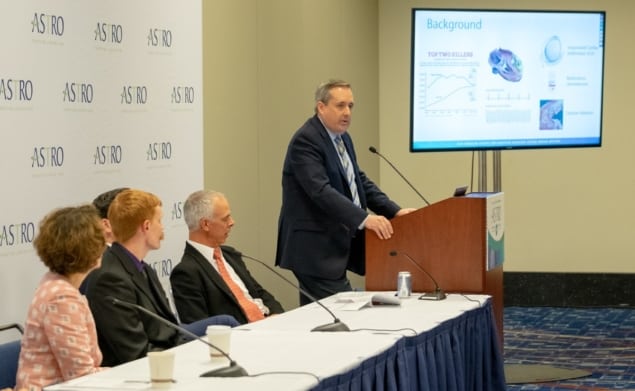
The ASTRO Annual Meeting takes place this week in Chicago. The world’s largest scientific meeting on radiation oncology, the event is predicted to attract over 10,000 attendees, including oncologists, medical physicists, dosimetrists, radiation therapists and other healthcare professionals from around the globe. Here is a small selection of some of the top-rated abstracts highlighted at this year’s meeting.
Cardiac radioablation tackles high-risk arrhythmias
Ventricular tachycardia (VT), the rapid onset of rapid, abnormal heartbeats, is the most lethal heart rhythm disorder. If not treated immediately with defibrillation to shock the heart back into a normal rhythm, VT can be fatal. A new treatment – EP-guided non-invasive cardiac radioablation (ENCORE) – uses a single, high dose of radiation to dramatically reduce VT episodes in high-risk heart patients.
“The results are very promising,” says lead author Clifford Robinson from Washington University School of Medicine in St. Louis. “The use of non-invasive radiation therapy is providing new hope for patients with life-threatening ventricular arrhythmias and limited treatment options.”
Patients at risk for VT are usually given an implantable cardioverter defibrillator (ICD). While shocks from an ICD can be life-saving, they are painful and can result in poor quality-of-life. Patients with repeated VT often receive catheter ablation, an invasive and risky procedure that requires general anaesthesia, and only has a 50% chance of stopping arrhythmias from recurring.
The non-invasive ENCORE procedure fuses electrical (electrocardiogram) and imaging (CT, MRI and PET) data to pinpoint the scar tissue in the heart responsible for the arrhythmias. This region is then targeted with a single dose of stereotactic body radiotherapy (SBRT), with no general anaesthesia needed.
In a phase I/II prospective trial, Robinson and his team treated 19 patients with life-threatening cardiac arrhythmia using a single 25 Gy fraction of SBRT. ENCORE reduced VT episodes by 94% in the first six months. Longer-term follow-up revealed that in 78% of patients, this reduction persisted for more than two years after treatment. Overall survival was 74% after one year and 52% after two.
Serious toxicity was low, but three serious adverse events were observed more than two years after treatment. This is not surprising, explains Robinson, as the patients were often being treated as a last line of defence because they were too sick to undergo further catheter ablation.
An additional benefit of ENCORE, Robinson notes, was the reduction in required medication. “These patients were on heavy doses of medications, with side effects such as liver damage, lung damage, nausea and thyroid problems,” he says. “After they were treated, we saw reduced VT, reduced medication and improved quality-of-life, at least in the intermediate term.”
Radiotherapy can reinvigorate the immune system
Non-small-cell lung cancer (NSCLC) is often diagnosed at a late stage when tumours have already spread, making it difficult to cure. Now, researchers from Yale School of Medicine have shown that delivering SBRT after patients no longer respond to immunotherapy reinvigorates the immune system in some patients with metastatic NSCLC, increasing progression-free survival.

“This study provides one more important piece of data that indicates that, for some patients, the immune system can be a really powerful tool to combat metastatic lung cancer,” explains lead author Allison Campbell from Yale Cancer Center. “It points us in the direction of places to look for biomarkers that might predict which patients would best respond to this type of therapy.”
In the phase II prospective trial, Campbell and her team treated a single cancerous lesion with SBRT in NSCLC patients whose cancer had continued to spread after immunotherapy. They studied 56 patients with two or more tumours, six of whom had already received immunotherapy and immediately underwent SBRT. The other 50 began immunotherapy with pembrolizumab at the start of the trial. Of these, 16 experienced disease progression, at which point they were treated with SBRT.
A total of 21 patients completed both treatments and lived an average five months longer without disease progression. In two patients, tumours outside the treated area shrank by 30% or more (attributed to the abscopal effect) and stayed that way for more than a year. Ten patients experienced disease stabilization following SBRT.
Analysing patients’ peripheral blood cells suggested that T cells played an important role in the immune system response. “We found two things that correlated with patients living longer without their disease progressing,” says Campbell. “Those were T cells infiltrating the tumour before immunotherapy, and the presence of immune-related side effects during the course of treatment, such as inflammation of the lung or gastrointestinal tract.”
In patients who responded well to the combination therapy, the researchers saw a population of CD8 T cells that looked more excited, while in poor responders, they saw a population of CD4 T cells with inhibitory markers. “The bigger picture here is that there are signatures in the peripheral blood that are promising avenues for future identification of people who will respond well to SBRT combined with immunotherapy,” Campbell notes.
The next step will be to validate the findings in a larger population, such as a phase III randomized trial.
Machine learning model predicts irradiation side effects
Radiotherapy plays an integral role in the management of head-and-neck cancers, but can also cause adverse side effects such as sore throat, mouth sores, loss of taste and dry mouth. Severe sore throats can make it difficult for the patient to eat and may lead to weight loss or require temporary insertion of a feeding tube.
For the first time, a machine learning model has accurately predicted two major toxicities associated with head-and-neck radiotherapy: significant weight loss and the need for feeding tube placement. Being able to identify which patients are at greatest risk would allow radiation oncologists to take steps to prevent or mitigate possible side effects.

“In the past, it has been hard to predict which patients might experience these side effects,” explains lead author Jay Reddy from The University of Texas MD Anderson Cancer Center. “Now we have a reliable machine learning model, using a high volume of internal institutional data, that allows us to do so.”
Reddy and his team developed models to analyse large sets of data, merged from electronic health records, an internal web-based charting tool and the Mosaiq record/verify system. The data included more than 700 clinical and treatment variables for head-and-neck cancer patients who received more than 2000 courses of radiation therapy from 2016 to 2018.
The researchers used the models to predict three endpoints: significant weight loss, feeding tube placement and unplanned hospitalizations. They then validated the results from the best-performing model against 225 subsequent consecutive radiation treatments.
The models predicted the likelihood of significant weight loss and need for feeding tube placement with a high degree of accuracy. They could not, however, predict unplanned hospitalizations with sufficient clinical validity. Reddy notes that adding more training data could improve the accuracy. “As we treat more and more patients, the sample size gets bigger, so every data point should get better. It’s possible we just didn’t have enough information accumulated for this aspect of the model,” he explains.

ASTRO: a focus on stereotactic ablative radiotherapy
While the machine learning approach can’t isolate the factors that lead to negative side effects, it can help patients and clinicians understand what to expect during the course of treatment. Machine learning models could also potentially predict which treatment plans would be most effective for different types of patients and enable more personalized approaches to radiation oncology.
“Machine learning can make doctors more efficient and treatment safer by reducing the risk of error,” says Reddy. “It has the potential for influencing all aspects of radiation oncology today – anything where a computer can look at data and recognize a pattern.”



